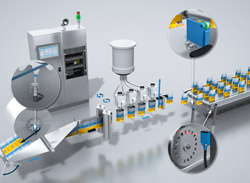
Posted to News on 1st Jun 2015, 16:28
Sick launches 'industry first' smart sensors
Sick has built powerful new functions into everyday sensors to deliver a glimpse of the future for manufacturing automation. Sick believes it is the first company worldwide to launch advanced smart sensors across its product ranges.

Smart sensors are a step forward in sensing performance, equipping photoelectric, magnetic and proximity sensors with powerful on-board processing capability to optimise machine technologies and automation on high-speed production lines.
As chip technology has enabled more functionality to be packed into ever smaller devices, Sick has identified opportunities to integrate advanced automation capability into the sensors themselves.
David Hannaby, Product Manager for Presence Detection at Sick UK, says: "By building advanced intelligence into standard sensors, Sick has made sensors 'smart' and achieved a world first. Smart sensors perform complex process functions locally, moving them away from the PLC to the sensor itself.
"Real-time events can be locally processed without waiting for the raw data to be uploaded to the central PLC program, processed and information extracted before action. Speed restrictions due to heavily-loaded networks are avoided and demands on the central computing functions are massively reduced."
Advanced functions that have already been developed by Sick for smart sensors include a high-speed counter, timer, false tripping suppression, a speed and acceleration monitor and time-based measurement function to track and identify products for sortation and picking. Currently, typical sensors that can be specified with these functions include the Sick W4S-3, WTB12-3 and WL12-3.
Smart sensors build on the existing sensor capabilities and can also share the results and data with the control system PLCs via IO-Link using standard sensor cables.
A wide selection of IO-Link gateway cards is available from the major PLC manufacturers to integrate smart sensors into automation networks; with smart sensors able to multi-task, many traditional sensor tasks can be combined, thereby reducing equipment costs.
Smart examples
Embedding a high-speed counting function into a smart sensor enables high-performance monitoring and measurement of machine speeds, leading to accurate detection and counting. An optical sensor, for example, can therefore detect and count products on a production line and transfer the results to the control system. A smart sensor can use time-based position measurement to calculate product length, or distances between objects on a high-speed conveyor, to ensure they are the right size or in precisely the right position, for example for picking or dimensional measurements of packages.
With the ability to suppress false signals (debouncing) from an anomalous triggering event in difficult environments such as sawdust and spray, or with product protrusions, smart sensors can make real-time decisions that reduce central computing load and network signal delays and errors.
Product profile recognition and timing functions can also be combined to provide product verification capability to ensure products are of the right shape or in the correct position for tasks such as picking, sorting or being matched to the correct packaging.
Even time tracking can be incorporated thanks to the accuracy of in-sensor time evaluation that assigns a time value for accurately locating a product further along the product line despite signal delays in network communication with the central processor. Also precise real-time location provides rapid, localised distance sensing to measure product lengths and spacing. As well as improving productivity and quality, real-time location is useful when accurate product slippage monitoring is required for a moving belt.
David Hannaby adds: "Smart sensors take processing load away from central control systems and deliver huge potential in additional flexibility, reliability and throughput for automated production tasks, as well as reducing costs and quality issues. The customer response to date has been excellent, and Sick is already extending smart functionality into a wider range of sensors and introducing more functions."
For more information on the Sick smart sensor programme, go to www.sick.co.uk.
Want the latest machine building news straight to your inbox? Become a MachineBuilding member for free today >>

















